GM Enhanced Super Cruise Review: Hands-Free Driving Adds Auto Lane-Change
- Hands-free attention monitor is unexpectedly liberating
- Automatic lane change works smoothly & naturally
- GM's human-like driving is relaxingly proficient
- Availability is finally expanding across GM's portfolio
- Super Cruise looks set to remain an expensive option
- Only works on mapped highways
- Requires an OnStar subscription after the bundled period
- This isn't autonomous driving - you're still responsible
You can't buy an autonomous car yet, but you can get some seriously impressive help behind the wheels on the highways. GM's Enhanced Super Cruise adds automatic lane changing to its hands-off driver assistance, a long-anticipated feature that arrives just as the automaker prepares to nudge the technology into the spotlight. As I discovered in the 2021 Escalade, however, it has a few other new tricks up its sleeve too.
Super Cruise launched back in 2017 on the Cadillac CT6, but it's only this year that it's spreading to more models. The 2021 Escalade is first, with Cadillac's CT4 and CT5 sedans to follow plus the upcoming Lyriq EV, but it's also spreading to other models under the General Motors umbrella, beginning with the upcoming Chevrolet Bolt EUV electric crossover. For that reason, I'll be referring to it as GM Super Cruise now, rather than Cadillac Super Cruise.
At launch, Super Cruise could basically do two things: maintain your pace with traffic, and hold you centered in the lane. To get that lane-centering right, GM looked to LIDAR. Not on the Super Cruise car itself, but on a fleet of mapping vehicles that built up high-definition cartography of divided highways across the US and Canada. By combining those with a high-resolution GPS sensor, plus the other sensors on the vehicle, it gives Super Cruise much greater accuracy as to where it is on the road.
The other big difference is where your hands have to be. Most combinations of adaptive cruise control and lane-keeping rely on contact with the steering wheel to reassure the system you're poised and ready to take over should it need to deactivate. Super Cruise, however, has a camera mounted on the steering column, which tracks where you're looking to make sure you're paying sufficient attention to the road ahead.
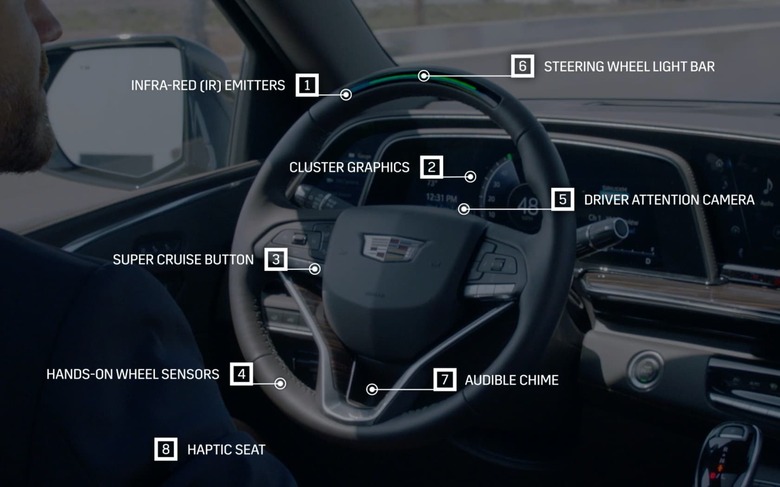
If you're not – which typically means looking away for around 4-6 seconds, though that's situation-dependent – a light bar built into upper half of the steering wheel flashes to bring your attention back. If that doesn't grab you, Super Cruise escalates through more aggressive flashes, seat-buzzes, and sounds, then will eventually deactivate and the system can even bring the car to a safe halt, summoning help via OnStar.
What Enhanced Super Cruise brings, though, is a feature that was long conspicuous by its absence. Several cars have offered automatic lane changing for some time now, typically trigged by turning on the indicator and then allowing the vehicle to move you into the adjacent lane by itself. Super Cruise, however, has been limited to just the lane you're in.
In fact, if you wanted to switch lanes, you'd need to overrule Super Cruise first. Pulling on the wheel, or indicating, would temporarily deactivate the system; you'd manually change lane, wait for Super Cruise to reacquire its position, and then the light bar would turn green to show it was back in control of the steering.
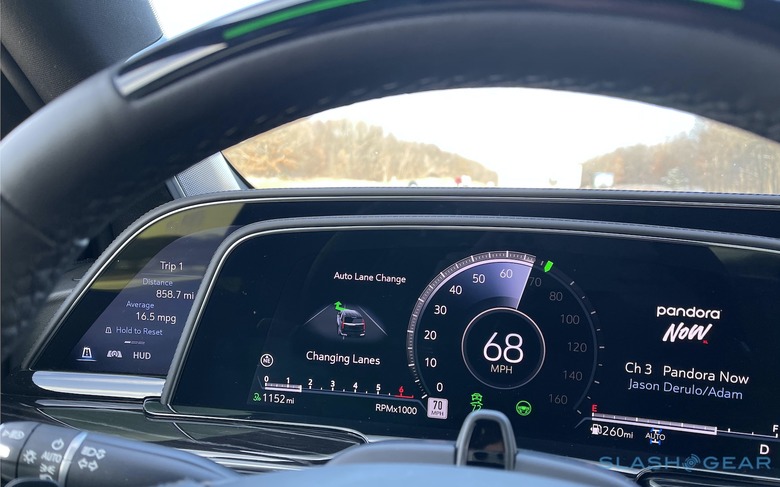
With Enhanced Super Cruise, you just have to hit the indicator. A graphic comes up on the Escalade's all-digital instrumentation, showing it's looking for a gap in traffic, and then eventually the SUV moves over. Once it's centered in the new lane you get a message confirming the maneuver was completed, and you can turn the indicator off.
Honestly, it sounds simple, and I confess I did wonder why it took GM quite so long to add it in. The reality is, while we humans may make lane-changing fairly simple, it's actually a considerable challenge to do safely and consistently in a semi-automated way, particularly if you also want to avoid riling up other motorists.
First off, it demands new hardware. GM updated all the sensors it uses, in particular extending the range of the rear radars. There's more compute power onboard, too, and Enhanced Super Cruise taps the new electrical architecture used in the automaker's latest models. It's for that reason that existing Super Cruise users can't upgrade their CT6 to support automatic lane changing, Cadillac says: the hardware just isn't there to power it.
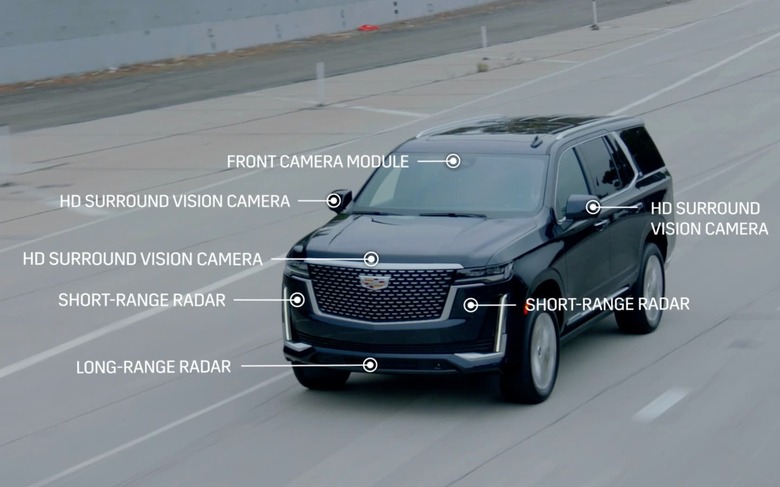
With that bevy of sensors, Enhanced Super Cruise is looking for a few things. For a start, it needs to find a suitably-sized gap in adjacent traffic: at almost 18 feet in length, an Escalade is not a small SUV. It's also looking further back in that neighboring lane, to make sure a fast-approaching vehicle isn't rapidly closing on you.
At the same time, GM has tried to dial in a more human style of driving for Enhanced Super Cruise. If the sensors spot a potential gap, for example, the car can speed up or slow down slightly to take advantage of it. You're not going to go zooming ahead, mind: I found it would do 2-3 mph above the speed I'd set at most, and it automatically returns to the pace you selected once the move is complete.
If there's a fast-moving vehicle coming up behind you in the target lane, meanwhile, Enhanced Super Cruise will probably pause and let it go past first. That way you're not cutting people off. The updated sensors are generally better at dealing with people cutting in on the lanes around you, too. Richer data in the map also means the automatic lane changing system knows if you're trying to switch into a non-Super Cruise enabled lane, or one which is about to end; if that's the case, it won't move over.
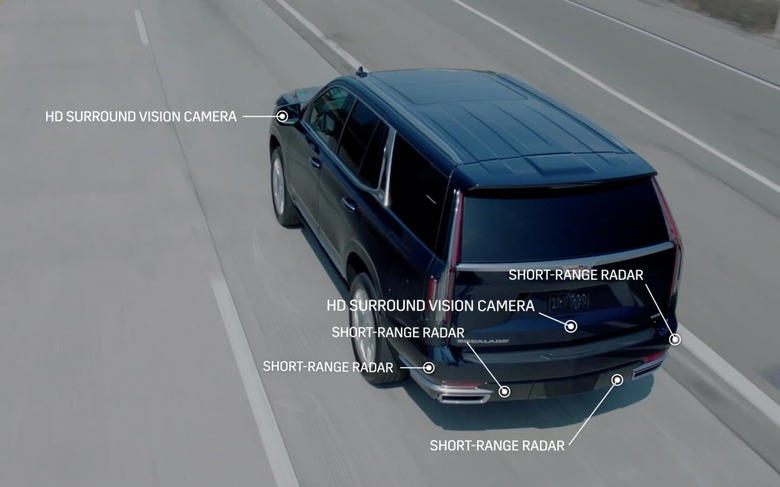
As always with any advanced driver-assistance system, there's a familiarity period when you first get behind the wheel. It's a little disconcerting to switch on Super Cruise and find the wheel moving of its own accord: I found my hands were hovering nearby for a while, just as my foot tends to hover over the gas and brake pedals when I first turn on adaptive cruise in a new vehicle.
Other updates have attempted to make that process a little more streamlined, at least from a technical standpoint. GM changed how Super Cruise enables, for one thing: you still turn on adaptive cruise first, then hit the Super Cruise button on the wheel, but you don't need to be dead-center in the lane for that now. Instead you can activate it and then position, at which point the system takes over the steering.
Meanwhile, Super Cruise in general is a fairly conservative driver, which helps build human confidence. If you're looking for a car to whip through rush hour traffic, making the most of every possible gap (even if that generates some frustration among your fellow commuters) then Enhanced Super Cruise isn't going to help. On busier lengths of highway, spaces in traffic that I might have pushed into proved unpalatable for GM's system. After a period of searching for a gap and not finding one that suits, the Escalade gives up the hunt and shows a "lane change canceled" message instead.
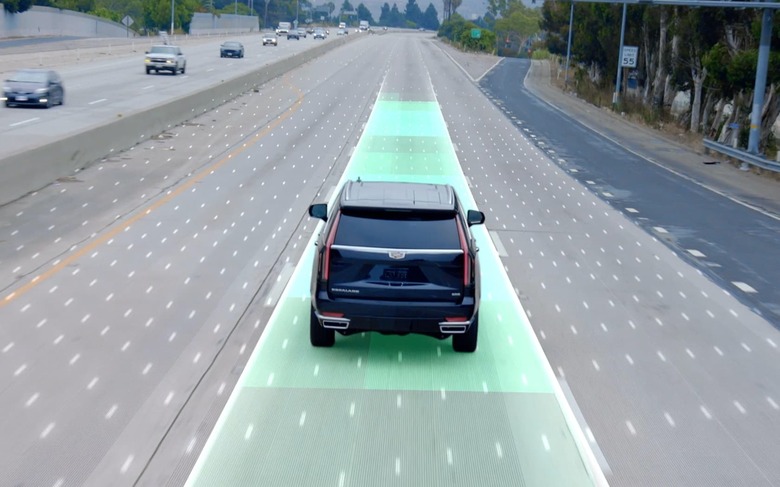
There's a lot going on in the background. While automatic lane changes are the headline feature, this Enhanced version also brings improved software for steering and speed control to make Super Cruise feel smoother and more natural. It'll slow down in a more human-like way if there's a sharper turn coming up, as well as shift over slightly in the lane if you're passing a big semi or similar. They're tiny tweaks – you only really notice that dynamic lane offset if you're looking out for it, with GM saying it's only about a foot of lateral bias at most – but it leaves Super Cruise feeling generally less rigid.
Cadillac won't have the highway hands-free driver assistance space to itself for long. Ford's Active Drive Assist is set to launch later this year, on the Mustang Mach-E electric crossover and the latest F-150 truck. It, too, will allow you to take your hands off the wheel just as long as the cameras can be sure you're watching the road, though it'll also be limited to areas where Ford has previously mapped.
The reality is that true autonomous driving – Level 4 or Level 5, where you can get into the vehicle, tell it where you want to go, and then rely on it to take you from A to B without further human intervention – is still some way out. It's a challenge that requires not only technical progress but regulatory and societal change too. Even if we see trials of ride-hailing services with driverless vehicles spread, they're likely to be small scale for some time to come.
For now, then, systems like Enhanced Super Cruise are about the closest you can get. To be clear, this is still a Level 2 offering: driver-assistance, not driver-replacement. You're still in charge of the vehicle, and responsible if something goes wrong.
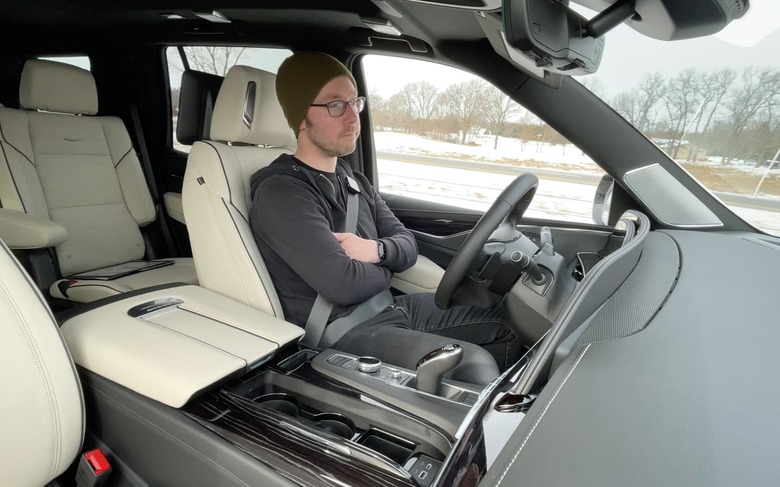
GM's attitude there is a lot more conservative than some other automakers. Tesla Autopilot, for example, has evolved in leaps and bounds while the Super Cruise team worked away in the background. Sometimes it feels like Tesla owners wake up every other week to a new tweak or feature to their driver-assistance tech: auto lane changing is a case in point, and while it may not be perfect on Tesla vehicles, it's been out in the wild there for years now.
What Tesla has refused to do, though, is hands-off driver attention monitoring. Honestly, that's the game-changer for me. I've driven most of the ADAS systems on the market right now, and personally there's nothing quite as liberating and relaxing on a long highway drive than not having to reassure the car that yes, you're in contact with the wheel, and yes, you're ready to take over should that be necessary.
It's not to say Enhanced Super Cruise is perfect. Mainstream sensor tech isn't infallible: snow or other inclement conditions can obscure cameras or other sensors, and lead to trouble identifying the lane lines. The system might be confident enough to hold you in the lane, but not have enough clarity to change lanes for you.
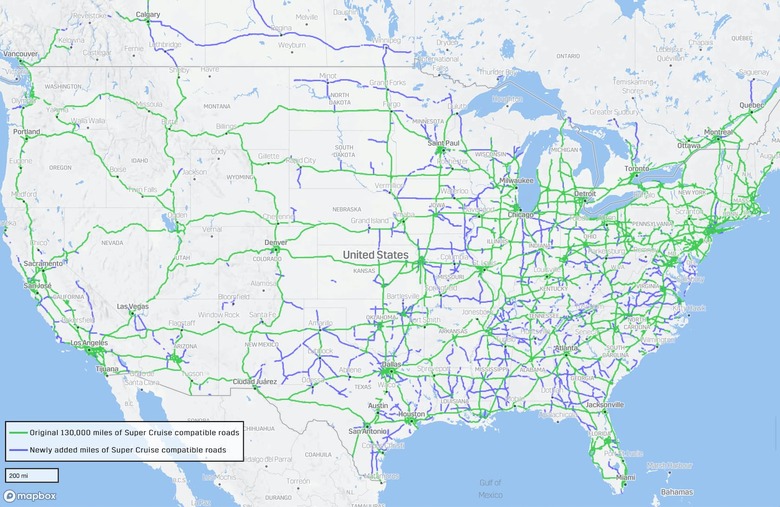
That reliance on high-definition mapping data, meanwhile, means it'll only work where GM has maps for it. Right now that means about 200,000 miles of highway and trunk road in North America, though the number is increasing and new updates get pushed out via OnStar. Super Cruise isn't used as a filter as you're planning a journey in the Escalade's navigation: you can't have it generate a route that specifically maximizes hands-free time. There's no cross-fleet aggregation of navigation data either, and if GM gets word of construction projects that could significantly impact the road it'll switch off Super Cruise functionality in that section until it can go back and re-map them.
In the process it also means you'll need an active OnStar connection, to receive the quarterly map updates. You get three years of Super Cruise data and service when you buy the vehicle, but after that you'll need to cough up a monthly or annual fee in order to keep both going.
That leads us neatly to the last big issue for GM's system: price. The 2021 Escalade is not a cheap SUV, and you need at least the Premium Luxury trim to add Super Cruise. However since you also need the Driver Assist Tech Package, Magnetic Ride Control, Adaptive Cruise Control, and several other options, you're looking at $8,850 more, all-in.
It gets a little cheaper on more expensive trims, since they have more of those mandatory extras as standard. At that point, Super Cruise is around $2,500. Still, you're looking at around $93,000 to get an Escalade with the system onboard. I wouldn't buy an Escalade just for Super Cruise, but then again I wouldn't buy an Escalade without Super Cruise, either.
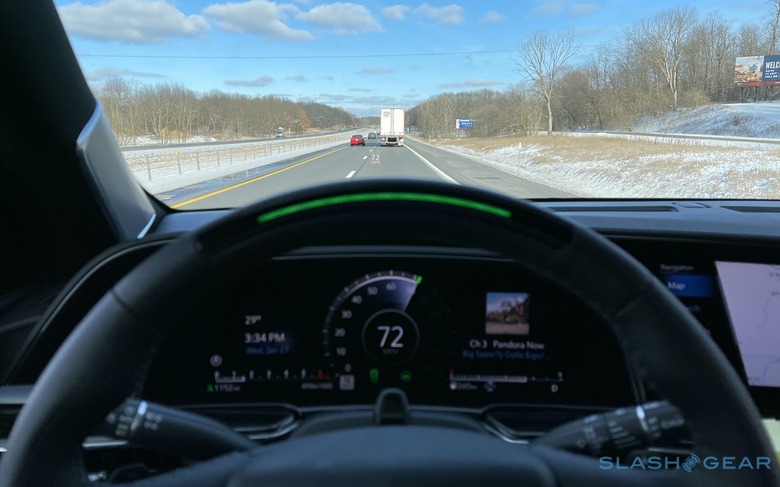
Just how much it might cost on other vehicles remains to be seen. GM, though, will need to be realistic. Ford has already confirmed pricing for Active Drive Assist: on the F-150, for example, you're looking at around $2,195 for most trims when it's finally available.
I don't begrudge either automaker for positioning their technologies as premium upgrades. It does, though, feel like a shame that systems such as Super Cruise have been the preserve of a very small subset of drivers. People who, GM says its feedback research shows, are ardent users of – and very happy with – Super Cruise, but who are still a definite minority.
That research also unearths another tidbit: apparently 85-percent of current Cadillac CT6 owners said they'd prefer, or even only consider, another vehicle equipped with the hands-free driver assistance system. Until now, what with the CT6 discontinued, that's left them with basically nowhere to go. As it gives Super Cruise the roll-out it deserves, at least, GM is finally addressing what could well have been the technology's biggest problem.
